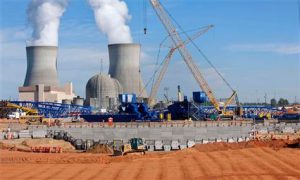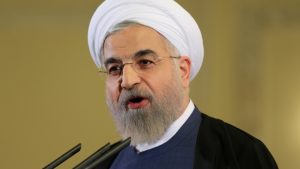
23-05-2017 (Important News Clippings)
To Download Click Here.
Economies of scale in nuclear power

The larger plant size should step up efficiency in generation. But more needs to be done: innovative design, standardised equipment and strict timelines for construction. It should be possible to curb project expenses with speedy execution. Project delays can make nuclear plants well-nigh unviable. Sourcing and managing component costs would be key. We need to purposefully reduce plant erection and commissioning periods so as to rein in capital and interest costs during construction, while upholding safety and reliability parameters. There is also the need to leverage international experience to step up efficiency in project implementation, operations and possible expansion.
We need to aim at fully commissioning modern modular nuclear power plants within four or five years of the first pour of concrete. It would keep the attendant price of power competitive, and also augment indigenous capacity to undertake nuclear commerce internationally. Concurrently, a larger nuclear power generation capacity and consequent increased baseload installation calls for a revamped power tariff policy. The Centre needs to call for time-of-day tariffs nationally and digital metering, as power demand during the hours of peak load is expected to steadily rise.
रूहानी की वापसी

From plate to plough: An unfulfilled farm manifesto
On agriculture, three years into the Modi government, while many steps have been taken to realise promises made in 2014, others have fallen by the wayside
With the Modi government completing three years in office, it is time to assess its performance in various sectors. We focus here on agriculture. Without robust growth in agriculture, “sabka saath, sabka vikas” will remain an empty slogan.There are two ways to evaluate the Modi sarkar’s performance: One, to evaluate its flagship programmes in agriculture and see their impact. The other is to go back to the BJP’s 2014 manifesto, and see how many of those promises have been fulfilled.In an earlier article, (‘The faraway fields’, IE, April 24) we evaluated the NDA’s flagship programmes, especially the Pradhan Mantri Krishi Sinchayee Yojana (PMKSY), Fasal Bima Yojana (PMFBY) and e-NAM. The conclusion was that they were all steps in the right direction but so far, their impact has not been felt. Perhaps tangible results won’t be seen before 2019.
Here, we look at major promises made in the election manifesto and how far the Modi government has progressed in turning those promises into reality. The BJP manifesto stated: “BJP commits highest priority to agricultural growth, increase in farmers’ income and rural development. BJP will increase public investment in agriculture and rural development; take steps to enhance profitability in agriculture by ensuring a minimum of 50 per cent profits over the cost of production, cheaper agriculture inputs and credit, introducing latest technologies and high-yielding seeds and linking MGNREGA to agriculture.”There were other promises too, in terms of bringing down food inflation, creating a price stabilisation fund and reforming the food management system by unbundling FCI into three parts, the dissemination of real-time data to farmers, and setting up a National Agriculture Market. The manifesto promised that the government would introduce crop planning based on soil assessment with mobile soil testing labs set up.
On the completion of three years, we find that while a number of steps have been taken to realise these promises, several others have fallen by the wayside. There is hardly any talk now of ensuring 50 per cent profit to farmers; instead, we are grappling with the new promise of doubling farmers’ incomes in five years. The reforms in the food management sector have been almost forgotten. There has been hardly any initiative to try DBT for food subsidy on a large-scale despite the recommendation of the high-level committee under Shanta Kumar.
The idea of a price stabilisation fund, which started with a corpus of Rs 500 crore to tackle high onion prices, has enlarged to more than Rs 3,500 crore, building a buffer stock of pulses of almost 2 million tonnes. Given the short shelf life of pulses, the challenge is to continuously rotate this stock to stabilise prices. Since most states are reluctant to distribute pulses under the PDS, procuring agencies will have to sell in the open market or give to large organisations like the army. So far, just 1.2 lakh tonnes have been sold from the buffer stock; even the quantity procured/imported in 2015-16 is yet to be disposed of. That is worrying as quality will deteriorate fast.
Another major initiative of the government was to issue soil health cards to all farmers once in two years. Building from the experience of Gujarat, the idea was that farmers will make good use of information and the application of fertilisers will be in accordance with soil needs. A target of 14 crore cards was fixed against which six crore cards have been distributed so far. Most states have shown only a lukewarm response; hence, expected benefits of the application of appropriate doses of fertiliser have not been experienced. UP, Punjab, Haryana, Rajasthan and Bihar have shown poor performance in testing soil samples.
There are indications that a major change in the procedure for the disbursement of the fertiliser subsidy is likely to be rolled out from July 2017. Fertiliser companies will be paid subsidy only when the dealer has actually sold the fertiliser. We do not think the scheme will take into account the health of soil and the actual need of nutrients while reimbursing subsidy to the companies.A better way would have been to directly transfer the fertiliser subsidy to farmers’ accounts and free up fertiliser prices, as recommended by the Shanta Kumar panel. That would have automatically encouraged farmers to use the information available in the soil health cards.
And finally, a word about doubling farmers’ income which was announced by the PM in a public meeting at Bareilly on February 28, 2016. PM Modi said: “I urge all the states to give priority to agriculture and then see the changes.” Since then, the bureaucracy and Niti Aayog have been busy justifying how the doubling of farmers’ incomes in five years can be achieved, without officially spelling out whether this is real income or nominal income. For now, this slogan is just shifting the goal post of 50 per cent profits over cost.Overall, agriculture is still limping at just 1.7 per cent annual average growth during the Modi government. A majority of farmers are struggling to survive.
Coal comeuppance: on coal block allocation case
The coal block allocation case may become a benchmark for other ongoing prosecutions
सख्त कदमों से ही सुधरेगी देश की आबोहवा
ज्यादा प्रदूषण वाली बीएस-3 गाड़ियों को विदा करके हम भले ही बीएस-4 गाड़ियों की ओर बढ़ गए हों, लेकिन इसका अर्थ यह नहीं है कि हमने प्रदूषण से भी मुक्ति पा ली है। यह मुक्ति निकट भविष्य में मुमकिन भी नहीं दिखती। इसका सबसे बड़ा कारण गाड़ियों की तादाद है, जो दिनोंदिन तेजी से बढ़ती जा रही है। हवा में लेड और हाइड्रो-कार्बन की मात्रा दोगुनी होने का सबसे बड़ा कारण दोपहिया वाहन हैं। ट्रकों के बाद प्रदूषण फैलाने में दोपहिया वाहन सबसे आगे हैं, क्योंकि कुल वाहनों में इनकी हिस्सेदारी तकरीबन 60 फीसदी है। अकेले राजधानी दिल्ली में इस समय 88 लाख गाडि़यां पंजीकृत हैं। इनमें से 56 लाख दोपहिया वाहन हैं, जिनकी संख्या सबसे तेजी से बढ़ रही है। 26 लाख से ज्यादा कारें हैं, जिनमें से लाखों रोजाना सड़कों पर निकलती हैं। समस्या की विकरालता का अंदाजा इसी बात से लग जाता है कि वायु प्रदूषण से होने वाली मौतों में पूरी दुनिया में भारत का स्थान दूसरा है। इसका खुलासा ग्लोबल बर्डन ऑफ डिजीज की 2017 की रिपोर्ट करती है। इससे होने वाली बीमारियों और इसके स्वास्थ्य पर पड़ने वाले असर अनगिनत हैं।आईआईटी, कानपुर की रिपोर्ट में खुलासा हुआ है कि दिल्ली की जहरीली हो चुकी हवा में 100 से भी ज्यादा विषैले रसायन घुले हुए हैं। कुछ साल पहले जब सीएनजी वाहनों को अपनाया गया, तो प्रदूषण कुछ कम हुआ था, लेकिन यह सकारात्मक असर बहुत पहले खत्म हो चुका है। रिपोर्ट के अनुसार, दिल्ली-एनसीआर में प्रदूषकों के स्तर में कमी लाने तथा इलाके की हवा को सुरक्षित मानकों में लाने के लिए हस्तक्षेप की जरूरत है। इसमें 76 फीसदी तक कमी की बेहद जरूरत है।
राजधानी की हवा में ओजोन का स्तर तीन गुना बढ़ चुका है। यह गंभीर खतरे का संकेत है। इस मामले में हम समूची दुनिया में पहले पायदान पर हैं। मानक के अनुसार, ओजोन का स्तर 100 एक्यूआई से ज्यादा नहीं होना चाहिए, जबकि बीते दिनों राजधानी के विभिन्न इलाकों में ओजोन का स्तर 300 से अधिक था। हवाई अड्डे के आसपास की हवा में इसका स्तर तो 321 से पार पहुंच गया था। गुरुग्राम और उसके आसपास के इलाके में इसका स्तर 317 के करीब था। असलियत यही है और वैज्ञानिक भी इसकी पुष्टि करते हैं कि गाडि़यों से उत्सर्जित होने वाली गैसें व हवा में हाइड्रा-ेकार्बन की मात्रा अधिक होने पर तापमान 40 डिग्री से अधिक हो जाता है, ऐसी स्थिति में गैसें आपस में क्रिया करके घातक ओजोन गैस बनाती हैं। नतीजतन प्रदूषण के स्तर में वृद्धि हो जाती है। ओजोन सांस की बीमारियों से पीड़ित रोगियों को सबसे ज्यादा प्रभावित करती है। यह सांस के जरिये रोगी के शरीर के विभिन्न हिस्सों में पहुंचती है। विशेषज्ञों का मानना है कि ओजोन को नियंत्रित करने के लिए तत्काल कदम उठाने की जरूरत है। गाडि़यों से निकलने वाले धुएं पर नियंत्रण के साथ ही पावर प्लांट, फैक्टरियों-कारखानों के धुएं पर भी लगाम लगाई जानी चाहिए। अमेरिकी शोधकर्ताओं के अनुसार, जिन इलाकों में वायु प्रदूषण की मात्रा अधिक होती है, वहां रहने वाली महिलाओं को स्तन कैंसर होने का खतरा ज्यादा होता है।
राजधानी दिल्ली तो सिर्फ एक उदाहरण है। वायु प्रदूषण की समस्या से कमोबेश समूचा देश जूझ रहा है। कोई महानगर, शहर, कस्बा, धार्मिक स्थल ऐसा नहीं है, जो प्रदूषण की मार से बचा हो। हां, इसे झुठलाया नहीं जा सकता कि दिल्ली की हवा में ज्यादा प्रदूषण है। नीति आयोग भी इसकी पुष्टि करता है। आयोग की मानें, तो कोयला आधारित बिजली संयंत्र, ईंट भट्ठे, खासकर डीजल से चलने वाले वाहन, हीटिंग आग, धूल और उत्तर भारत में खासकर पंजाब, हरियाणा व पश्चिमी उत्तर प्रदेश में फसलों के अवशेषों को जलाना- ये सभी वायु प्रदूषण के प्रमुख कारक हैं। उसके अनुसार, देश भर में सुधारात्मक कार्रवाई के साथ-साथ विभिन्न प्रतिबंधों और यातायात कानूनों का सख्ती से पालन बेहद जरूरी है। इस पर अंकुश के लिए आयोग का मानना है कि वह पांच सूत्रीय एजेंडा अपनाना होगा, जिसमें पेट्रोल-डीजल पर अधिक टैक्स, उच्च पार्किंग दर, कोयला आधारित बिजली संयत्रों को बंद करना, बैटरी चालित वाहनों का अधिकाधिक इस्तेमाल और सार्वजनिक परिवहन शामिल है।



